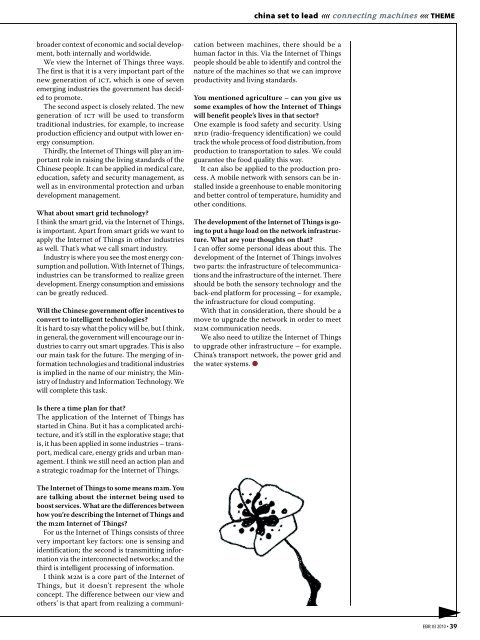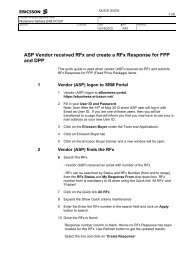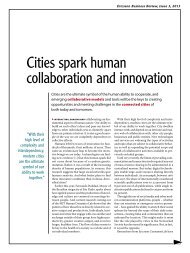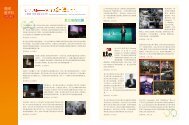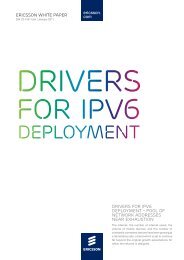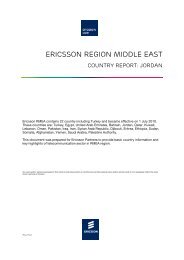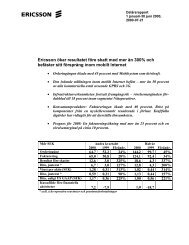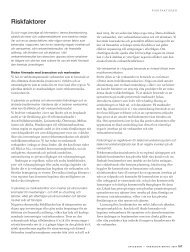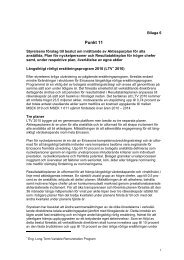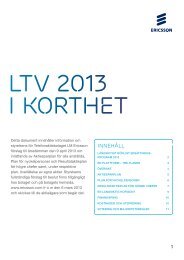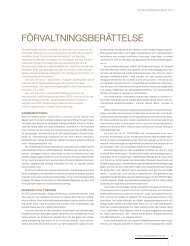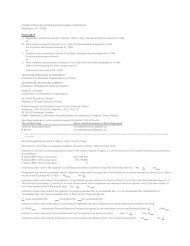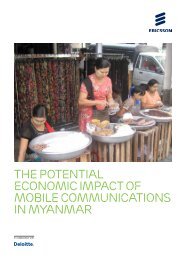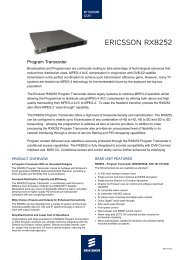Telenor's - Ericsson
Telenor's - Ericsson
Telenor's - Ericsson
- TAGS
- ericsson
- www.ericsson.com
Create successful ePaper yourself
Turn your PDF publications into a flip-book with our unique Google optimized e-Paper software.
oader context of economic and social development,<br />
both internally and worldwide.<br />
We view the Internet of Things three ways.<br />
The first is that it is a very important part of the<br />
new generation of ict, which is one of seven<br />
emerging industries the government has decided<br />
to promote.<br />
The second aspect is closely related. The new<br />
generation of ict will be used to transform<br />
traditional industries, for example, to increase<br />
production efficiency and output with lower energy<br />
consumption.<br />
Thirdly, the Internet of Things will play an important<br />
role in raising the living standards of the<br />
Chinese people. It can be applied in medical care,<br />
education, safety and security management, as<br />
well as in environmental protection and urban<br />
development management.<br />
What about smart grid technology?<br />
I think the smart grid, via the Internet of Things,<br />
is important. Apart from smart grids we want to<br />
apply the Internet of Things in other industries<br />
as well. That’s what we call smart industry.<br />
Industry is where you see the most energy consumption<br />
and pollution. With Internet of Things,<br />
industries can be transformed to realize green<br />
development. Energy consumption and emissions<br />
can be greatly reduced.<br />
Will the Chinese government offer incentives to<br />
convert to intelligent technologies?<br />
It is hard to say what the policy will be, but I think,<br />
in general, the government will encourage our industries<br />
to carry out smart upgrades. This is also<br />
our main task for the future. The merging of information<br />
technologies and traditional industries<br />
is implied in the name of our ministry, the Ministry<br />
of Industry and Information Technology. We<br />
will complete this task.<br />
Is there a time plan for that?<br />
The application of the Internet of Things has<br />
started in China. But it has a complicated architecture,<br />
and it’s still in the explorative stage; that<br />
is, it has been applied in some industries – transport,<br />
medical care, energy grids and urban management.<br />
I think we still need an action plan and<br />
a strategic roadmap for the Internet of Things.<br />
The Internet of Things to some means m2m. You<br />
are talking about the internet being used to<br />
boost services. What are the differences between<br />
how you’re describing the Internet of Things and<br />
the m2m Internet of Things?<br />
For us the Internet of Things consists of three<br />
very important key factors: one is sensing and<br />
identification; the second is transmitting information<br />
via the interconnected networks; and the<br />
third is intelligent processing of information.<br />
I think m2m is a core part of the Internet of<br />
Things, but it doesn’t represent the whole<br />
concept. The difference between our view and<br />
others’ is that apart from realizing a communi-<br />
china set to lead «« connecting machines «« THEME<br />
cation between machines, there should be a<br />
human factor in this. Via the Internet of Things<br />
people should be able to identify and control the<br />
nature of the machines so that we can improve<br />
productivity and living standards.<br />
You mentioned agriculture – can you give us<br />
some examples of how the Internet of Things<br />
will benefit people’s lives in that sector?<br />
One example is food safety and security. Using<br />
rfid (radio-frequency identification) we could<br />
track the whole process of food distribution, from<br />
production to transportation to sales. We could<br />
guarantee the food quality this way.<br />
It can also be applied to the production process.<br />
A mobile network with sensors can be installed<br />
inside a greenhouse to enable monitoring<br />
and better control of temperature, humidity and<br />
other conditions.<br />
The development of the Internet of Things is going<br />
to put a huge load on the network infrastructure.<br />
What are your thoughts on that?<br />
I can offer some personal ideas about this. The<br />
development of the Internet of Things involves<br />
two parts: the infrastructure of telecommunications<br />
and the infrastructure of the internet. There<br />
should be both the sensory technology and the<br />
back-end platform for processing – for example,<br />
the infrastructure for cloud computing.<br />
With that in consideration, there should be a<br />
move to upgrade the network in order to meet<br />
m2m communication needs.<br />
We also need to utilize the Internet of Things<br />
to upgrade other infrastructure – for example,<br />
China’s transport network, the power grid and<br />
the water systems. ●<br />
▶<br />
EBR #3 2010 39


